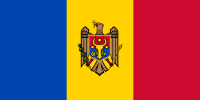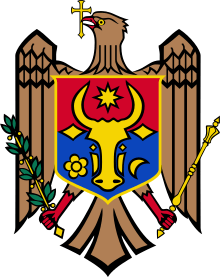Cinema of Moldova
| Cinema of Moldova | |
|---|---|
|
Cinema Patria Bălți | |
| Number of screens | 29 (2011)[1] |
| • Per capita | 0.9 per 100,000 (2011)[1] |
| Main distributors |
Colaj Elatrentservice Gaudeamus Cinema[2] |
| Produced feature films (2009)[3] | |
| Fictional | 1 |
| Animated | - |
| Documentary | - |
| Number of admissions (2012)[4] | |
| Total | 598,000 |
| • Per capita | 0.168 |
| Gross box office (2006)[5] | |
| Total | MDL 10 million |
| Part of a series on the |
| Culture of Moldova |
|---|
 |
| History |
| People |
| Festivals |
| Religion |
|
Art
|
| Literature |
|
Music and performing arts |
| Sport |
|
Monuments |
|
The cinema of Moldova developed in the early 1960s during the Soviet period, experiencing a flowering of about a decade and a half. Stagnation followed, and after the Moldavian SSR became independent in 1991, the industry almost completely disappeared.
History
On 26 April 1952 the USSR Ministry of Cinematography initiated the Documentary Film Studio in Chişinău. During the first year two documentaries, Kodry and Moldovan Cannery appeared. The picture directors were from Moscow and Odessa, as by that time there were no national workers in the field of cinema. Between 1952 and 1957, six documentaries were screened.
On 24 January 1957 the MSSR Council of Ministers took the decision to rename the "Documentary Film Studio of Chişinău" to the "Studio for Fiction Movies and Chronicle Documentaries from Chişinău" also named "Moldova-Film".
Filmography
In 1957, the first fiction comedy film was called Cînd omul nu-i la locul lui (When the man is not himself) after a script written by Ion Druta.
In 1968, the first cartoon film, The Goat with Three Kids, was released, a film inspired by Ion Creanga's fairy-tale with the same title. In 1972, the satirical series Usturici appeared.
Between 1952 and 1982, 120 fiction movies, 800 documentaries, 750 editions of the cinema magazine Soviet Moldova, 40 editions of Usturici and 40 cartoons were filmed at the Moldova-Film studio. It also dubbed 12 fiction movies and 70 short stories annually by the end of the 1980s.
A cinema was built in the beginning of the 1950s in the center of Chişinău, which is now part of the Moldovan "Patria" chain.
International recognition
The first internationally acclaimed success was the film of Moldovan producer Mihail Kalik - Lullaby (Russian: Колыбельная), released in 1960 at Moldova-Film studios. The movie was awarded the "Prize for Participation" at the international cinema competition at the Locarno International Film Festival, bringing attention to the emergent Moldovan film industry.
Another international success was Man Is Walking After the Sun (Man Is Following the Sun Russian: Человек идет за солнцем), written by Valeriu Gagiu and Mihail Kalik. The world press compared this movie to the Albert Lamorisse movie Le Ballon Rouge, where, just as in the Moldovan movie, the main hero was a little boy. Vadim Derbenev, the cameraman, was awarded the special jury diploma at the International Cinema Festival in Helsinki for his work.
Another one of the first Moldovan films was the Ataman of Codru (Russian: Атаман кодр), which enjoyed success in Asia and Latin America. The viewers called the movie Ataman Kadyr.
The Moldovan breakthrough in the world's cinema industry was a film written by Ion Druţă and producer and cameraman Vadim Derbenev - Last Month of Autumn (Russian: Последний месяц осени). The film received prizes at the Mar del Plata Film Festival, including the "Sympathy Prize of Viewers". Evgueniy Lebedev was awarded the main prize of the festival - the "Big Southern Cross" - in the best male role nomination. La Nación described the film as a "remarkably beautiful work". La Prensa wrote "This film, amongst all the mess that flooded the cinema world invites us to the sources of the true reachess of life". Besides appraisal in Argentina, the movie was awarded the Grand Prix at the Cannes Film Festival in 1966. At the International Film Festival Kino Pavasaris in Vilnius, the director Vadim Derbenev won "Best Production". However, in Vilnius, the film was awarded only the second main film prize, the first place being taken by Vytautas Žalakevičius's film Nobody Wanted to Die (Russian: Никто не хотел умирать).
Lăutarii by Emil Loteanu (producer Vitaliy Kalashnikov, composer Eugen Doga) was a success, particularly in Italy. The movie received four prizes, including the "Prize of Viewers' Sympathy" and the second main prize "Silver Shell". Norwegian newspaper Arbeiterbladet compared the Moldovan movie to the Broadway musical The Sound of Music. Czech weekly Film a Divadlo wrote "Every nation expresses to the best its deepest feelings, but the Moldovan one did it the best". In 1975, the movie won in the category of "Best Foreign Film", leaving behind traditional Hollywood productions. During the week of Soviet Cinema in Naples, the film was awarded the "Silver Nymph".
Red Meadows by Emil Loteanu was also another major Moldovan success at the Locarno International Film Festival. România Liberă highlighted the symbolism of this art work, which made it an unforgettable sight".
Very few films have been made in Moldova since independence: the government has failed to protect its domestic industry and funding is rare (save for occasional co-productions). The country also has the world's second-lowest cinema attendance rate.[6]
Cartoons
The animation movies produced at Moldova-Studios reach an international audience. The cartoon Haiduc, produced by Leonid Gorokhov and Yuriy Katsap, with scenario written by Vlad Druc, was awarded the Grand-Prix of the Cannes Film Festival in the cartoon category.
Personalities
The top Soviet pop star Sofia Rotaru starred in the musical movie filmed at Moldova-Film studios called Dnestrovskiye melodiy.
See also
References
- 1 2 "Table 8: Cinema Infrastructure - Capacity". UNESCO Institute for Statistics. Retrieved 5 November 2013.
- ↑ "Table 6: Share of Top 3 distributors (Excel)". UNESCO Institute for Statistics. Retrieved 5 November 2013.
- ↑ "Table 1: Feature Film Production - Genre/Method of Shooting". UNESCO Institute for Statistics. Retrieved 5 November 2013.
- ↑ "Table: Film installations, 1995-2011". National Bureau of Statistics. Retrieved 10 November 2013.
- ↑ "Table 11: Exhibition - Admissions & Gross Box Office (GBO)". UNESCO Institute for Statistics. Retrieved 5 November 2013.
- ↑ Steve Kokker and Cathryn Kemp. Romania & Moldova, p.35. Lonely Planet (2004), ISBN 1-74104-149-X
External links
| Wikimedia Commons has media related to Cinema of Moldova. |
- The history of the Molovan Film in figures and Images;
- Moldovan Cinema Encyclopedia;
- Moldovan Cinema Abroad;
